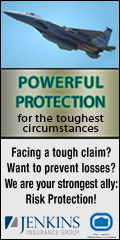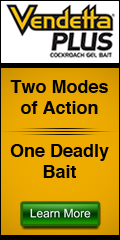
| June 2014 | Past Issues | Printer-Friendly | Advertise | Affiliates Search | Find a Pest Control Operator | PCOC.org |
|
EVP NOTES
As the summer season approaches, I wanted to use this space to let you all know that we at PCOC are doing a number of things that will focus the activity of pest control on pest control professionals. I am always comforted when I visit with legislators or state regulators by their reaction of amazement about our industry: how a trade association pioneered the regulation of an industry. This is truly unique and is worth instant credibility! I usually continue their education by letting them know about the licensing requirements in all three branches and the role that DPR, the Structural Pest Control Board and the Ag Commissioners play. I conclude by pointing out that it is a no brainer for the consumer to hire a professional. The public also needs to be educated about pest management, especially given the concerns and responsibilities toward our environment. When a person buys over-the-counter products from home improvement and hardware stores and the label reads "use 2 ounces," invariably they will use 4 ounces on the theory that it will do the job twice as effectively. That is why PCOC constantly emphasizes our "Hire A Professional" campaign — the theme of which is that for safety all around, the environment, pets and individuals, people need to hire a trained and responsible professional. Our new enhanced website will focus on the benefits of hiring a professional. The consumer will be able to see that the best decision in any environment is to hire a pest management professional. We will, in the coming months, be making it much easier for them to do just that! An enhanced search engine will give them all the information they need to find a PCOC member in their area. Unfortunately, we do not have a huge advertising budget. The PCOC Media Committee is working on ways that we can get the word out. Bumper stickers is one idea. Another is through Public Service Announcements (PSAs) , which radio stations will run. (They have to run a certain number during a week as part of their licensing agreement.) We also plan to explore the possibility of enlisting the help of DPR in this program since it will curb some of the abuses that take place in the over-the-counter pesticide use. Hiring a Professional is a vital concept that we all need to keep in our minds as we explain our industry to outsiders. It's an exciting challenge! LEGISLATIVE UPDATE
The 2013-2014 Legislative Session of the California Legislature is in progress. Click here for PCOC's Legislative Agenda. IN THE NEWS
 COMPLIANCE ON NEW INSURANCE AND BOND COVERAGE REQUIREMENTS COMPLIANCE ON NEW INSURANCE AND BOND COVERAGE REQUIREMENTS
FAILURE TO DO SO WILL RESULT IN SUSPENDED REGISTRATION
TO: REGISTERED COMPANIES In October 2013, the Structural Pest Control Board (Board) notified all registered companies and branch offices that Senate Bill (SB) 662 had been approved by the Governor and would be effective Jan. 1, 2014. SB 662 amended sections 8690, 8691, 8692, 8693, 8697 and 8697.3 of the Business and Professions Code by increasing the minimum amount of insurance and bond coverage required to be maintained by a registered company. The new minimums for registered companies are $500,000 for insurance and $12,500 for bonds. A certificate of deposit, in lieu of the insurance and/or bonds, is no longer accepted to satisfy the insurance and/or bonding requirement. Registered companies were notified that proof of these new minimum requirements had to be received by the Board no later than July 1, 2014. If you are receiving this notice, then the Board has not received proof of the new minimum requirements for insurance and/or bond. Failure to submit proof of these new requirements by July 1, 2014 will result in your company registration being suspended.
If you have any questions, please call the Board's Licensing Unit at (916) 561-8704.
WORKERS' SAFETY RESOURCES
I often get phone calls from members asking for safety meeting information. If you go through Cal/OSHA, you will get tons of information pertaining to construction and other related fields, but trying to get pest control related information is much more difficult. One of the great untapped resources PCOC offers is through our PCOC insurance program. They do not just offer insurance policies but also risk management. Our members can go to http://pcocinsurance.com/2011PCOCsafetyCD/index.htm for extensive resources concerning a variety of safety information — from respirators to an illness and injury prevention program. It also includes fall protection information, ladder safety, driving tips, heat safety, and much more...If you want safety meeting help or PowerPoint presentations on a variety of topics, this is the place to go. HEAT ILLNESS
With summer coming and increased temperatures the potential for heat illness also increases. Outdoor workers are most susceptible.
"Heat Illness" means a serious medical condition resulting from the body's inability to cope with a particular heat load, and includes heat cramps, heat exhaustion, heat syncope, and heat stroke (see T8 CCR 3395). Human beings need to maintain their internal body temperature within a very narrow range of a few degrees above or below 98.6 °F. People suffer from heat illness when their bodies are not able to get rid of excess heat and properly cool. The body losses its heat balance because it cannot shed heat at a fast enough rate. When the body starts to overheat the blood vessels get bigger and the heart beats faster and harder. More blood flows to the outer layers of the skin from the internal "core" so that the heat can be released into the cooler outside environment. If this process does not cool the body fast enough, or the outside air is warmer than the skin, the brain triggers sweating to cool the body. Sweat glands in the skin draw water from the bloodstream making sweat. The sweat evaporates and releases the heat from the body. During an hour of heavy work in hot weather, the body can easily sweat out one quart of water. Shifting blood to outer body layers (the "shell") causes less blood to go to the brain, muscles, and other organs (the "core"). Prolonged sweating can deplete the body of water and salt causing dehydration. Because the body loses water and the salts that are needed for the muscles to work, muscle cramping may occur. The physiological strain on the body from heat illness may cause the person to become dehydrated, weak, tired and confused. As dehydration gets worse the body can no longer keep its temperature within the normal range, sweating stops and severe heat illness occurs. In heatstroke, the person's body temperature rises rapidly damaging the brain, muscles and vital organs causing death. Heat Exhaustion – Signs and symptoms: Headaches, dizziness, lightheadedness or fainting, weakness and moist skin, muscle cramps, mood changes such as irritability or confusion, upset stomach or vomiting. Heat Stroke – Sign and symptoms: Sweating stops – skin is hot, red, and dry, mental confusion, losing consciousness, fainting, seizures or convulsions. Anyone experiencing these symptoms needs immediate medical help. 1. Move victim to cool area 2. Give small cup of water (if conscious and not nauseous) 3. Loosen and/or remove clothing 4. Fan and mist the person w/ water 5. Apply a water-soaked towel (or ice pack wrapped in towel) to head and ice pack to armpits Contact supervisor immediately. Anyone with symptoms must never be sent home or left unattended without a medical evaluation. As part of a heat illness prevention plan, you should remember four things:
Through Cal/OSHA online, you can get access to pamphlets and literature. For more information, visit the Cal/OSHA Heat Illness websites: Etex / Electro-Gun
Termite Control Celebrating 35 years providing a non-chemical termite treatment product to PCO's throughout the USA! Call and find out the benefits of leasing www.etex-ltd.com UPCOMING EVENTS
2014
June 19-21 PCOC Expo 2014
Harrah's Las Vegas Casino & Hotel
Las Vegas
Hotel Reservations Exhibitor Registration Attendee Registration June 20 Silent Auction Sponsored by Target Specialty Products, Leavitt Group and Drexel Harrah's Las Vegas Casino & Hotel
Board of Directors Meeting
Doubletree by Hilton Sonoma
Rohnert Park, Calif.
Dec 12-13 Board of Directors Meeting
Hilton Palm Springs
Palm Springs, Calif. Comings and Goings
Welcome to a new section of Newsbriefs! Here, we will give news from our members: new hires, retirements, etc. If you have some news you would like to share, please send a short sentence or two to jenai@pcoc.org. MEMBER NEWS
MEMBER VALUE PROGRAM
PCOC MONTHLY INSURANCE/SAFETY TIP
Avoiding Auto Accident Claims
Driving — something that most adults do every day — is one of the most dangerous tasks you can assign a worker. Consider the following facts:
What You Can Do to Improve Driver Safety
Hiring safe, conscientious drivers is the most important thing you can do to avoid work-related auto accidents. To start:
The "Coming and Going Rule" For an auto accident claim to be compensable, the worker must prove that the injury occurred while working. State laws generally exclude coverage for injuries employees receive while commuting to and from work, considering that the employee's personal time. However, exceptions exist to this "coming and going rule" where your workers' compensation would apply. For more information, please contact the PCOC Insurance Program Department of The Leavitt Group at (877) 860-7378 or, email us @ ProPest@Leavitt.com. NEW MEMBERS
FREQUENTLY REQUESTED INFORMATION
NPMA LOGIN FOR JOINT MEMBERSHIP LOGIN: 313501 PASSWORD: PCOC
Department of Fish & Game Department of Food & Agriculture Department of Pesticide Regulation (DPR)
www.cdpr.ca.gov DPR on Facebook www.facebook.com/capesticideregulation DPR on YouTube (see "playlists" for videos pertaining to new surface water regulations) www.youtube.com/user/californiapesticides DPR on Twitter twitter.com/ca_pesticides DPR LinkedIn www.linkedin.com/company/california-department-of-pesticide-regulation Healthy Schools Act http://apps.cdpr.ca.gov/schoolipm/ Structural Pest Control Board www.pestboard.ca.gov Find Your Legislator |
Pest Control Operators of California |
 |


